Swing, Tarzan, Swing! Ch.2: Maureen O'Sullivan & Johnny Weismuller
 Saturday, May 21, 2016 at 2:00PM
Saturday, May 21, 2016 at 2:00PM  one of many erotic moments in Tarzan the Ape Man (1932)New Miniseries! As we approach the release of The Legend of Tarzan (2016) we'll be ogling past screen incarnations of the Lord of the Apes each weekend like we're going to an old timey matinee.
one of many erotic moments in Tarzan the Ape Man (1932)New Miniseries! As we approach the release of The Legend of Tarzan (2016) we'll be ogling past screen incarnations of the Lord of the Apes each weekend like we're going to an old timey matinee.
We began by staring hard at Buster Crabbe's loincloth so as to avoid the acting and plotting. For chapter 2 we're moving to the main event: Johnny Weissmuller. He's the actor most often associated with the the Lord of the Apes since he played it 12 times and because he played it so well. There's a genuine guileness and in the moment feeling to his work that lets the ape man read more simple and pure than stupid, despite all the broken English. A few seasons ago on a weakly attended episode of 'Hit Me With Your Best Shot' we marvelled at how erotic the pre-code Tarzan the Ape Man (1932) was . Rather than rehash that film (though it is definitely worth your time), we jump ahead to its sequel Tarzan and His Mate (1934) which some argue is the best of the dozens of Tarzan films made during the studio era. Not I, as I think it's a notch below the 1932 original but in truth that's splitting hairs. The two films cling to each other as tightly as Jane holds on to her swinging man. More than most Tarzan films it's a direct sequel, constantly referencing events, locales, and characters from the original film.
When we left the jungle couple in 1932, Tarzan was already getting (ahem) good with his tongue. When audiences returned to see the next adventure in the Spring of 1934, Hollywood's "Pre-Code" era was ending. The code began to be rigidly enforced that year which meant there was one last burst of racy sexy times in the cinema that year for films that had already been shot. [More...]
So when we return to the jungle (aka, a sound stage with lots of rear projections and inserted stock footage), we find that Jane (Maureen O'Sullivan) is orgasmically happy with her decision to shack up with Tarzan and she's living a idyllic life in the jungle; Tarzan serves her breakfast in bed (a bed they clearly share) and more every morning and is ever eager to please her. Given all the delays in production on the sequel it's a good thing one last "sexy" film was shot in time: Some of the roles were recast, plans to shoot in Africa were scrapped when the budget rose considerably, and the director's chair rotated. Eventually the sole credit went to Cedric Gibbons, the art director, who IMPORTANT TRIVIA ALERT had designed the Oscar statuette that we all continue to worship today just a handful of years before this.
But back to the hot coupling. While the pre-code time is obvious right away in that we get partial male nudity from the villain and a topless native woman in the first 5 minutes, but it takes us a whole 24 minutes or so to get to the big draws of the movie: Tarzan & Jane. The film makes the very odd decision to play coy for its first two entire reels without its leading man or lady. At the beginning we merely follow two English men and their native hired hands (suspiciously treated like slaves but more on the racial politics later) as they hack their way through the jungle in search of Jane who they'd very much like to lure back to England. They're also in search of ivory. Jane, who is strangely dumb about Tarzan's ethics despite being clever about a lot of other things, has promised that Tarzan will help them in their ivory hunt. Oh Jane... there is NO WAY your nature loving husband is going to let these men rob a sacred elephant burial ground. He loves those pachyderms as much as he loves Cheetah and You.
At the end of the second reel, the ivory hunters are attacked by a frightening African tribe (wearing lots of ivory themselves) and then by a troop of apes (aka men in ape costumes). When all is seemingly lost the famous yodelling happens. Twenty-two minutes in Tarzan swings in and calls the Apes off demonstrating his dominion. Then Jane appears (with her own silly version of Tarzan's famous yell!), chats with her old friend Harry (Neil Hamilton, who later became Commissioner Gordon on the Batman TV series), and impulsively grabs his sleazy friend Martin's arm (a complete stranger to her mind you) because she believes she sees a poisonous scratch. Cue a very purposeful zoom-in to a lascivious sneer on Martin's (Paul Cavanaugh) face.
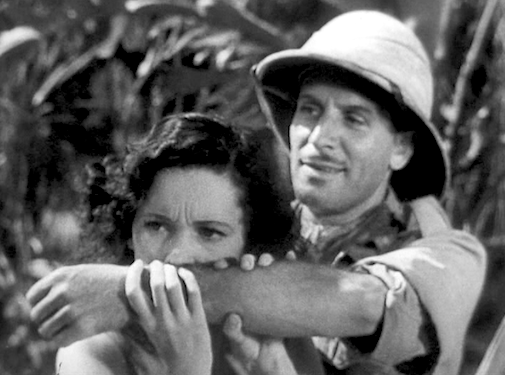
To underline the point that he wants Jane for himself, and is the villain, he will callously kill his own workers and local elephants if the whim strikes him. Jane is an incorrigible flirt even with obviously evil men but he takes it way too far, planting one on her lips (she's not happy about it, but blames herself. Because sexism). He even spies on her while she changes outfits which is really going out of his way to be a sleaze because Jane is practically naked before the spying even begins!
Basically every man in the Tarzan franchise wants Jane for himself. That will even come to include the directors. On the next picture the director John Farrow is brought in (though uncredited) and he marries Maureen O'Sullivan soon thereafter. Cue: baby Mia Farrow's entrance some years later.)
And who can blame the men really, since Jane is a hot piece? As her friend Harry puts it she's both "at home in Mayfair" and appealingly "savage". 1930s linguistic experts are not needed to translate this: Jane fills both the Madonna and Whore requirements of the male gaze. You can't really blame the men for ogling her though because the camera invites audiences to do it too.
This is true whether she's playing Damsel in Distress...
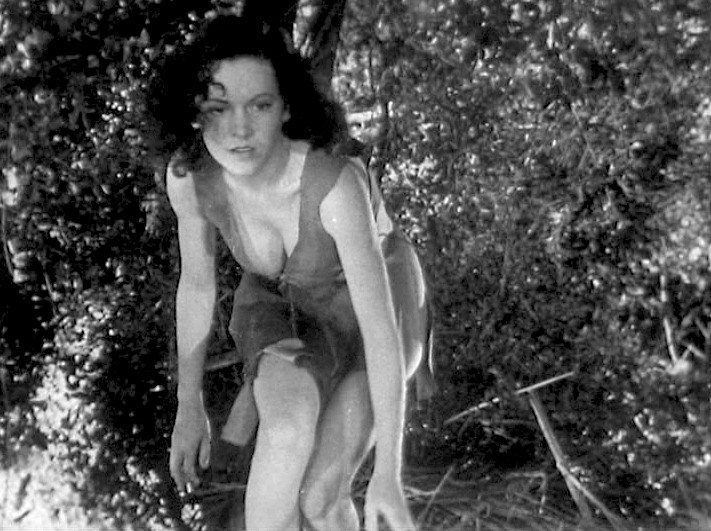 Jane about to be attacked by [insert wild animal here] In the 1934 picture she's attacked by rhinos, natives, leopards, lions, and alligators alike!
Jane about to be attacked by [insert wild animal here] In the 1934 picture she's attacked by rhinos, natives, leopards, lions, and alligators alike!
Enjoying a nude swim with Tarzan...
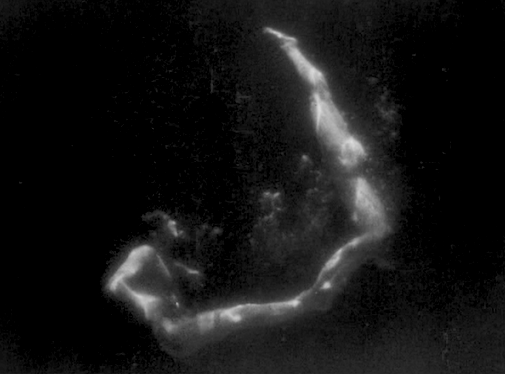 this justifiably famous underwater sequence is an erotic beauty
this justifiably famous underwater sequence is an erotic beauty
Pretending she's a Disney princess...
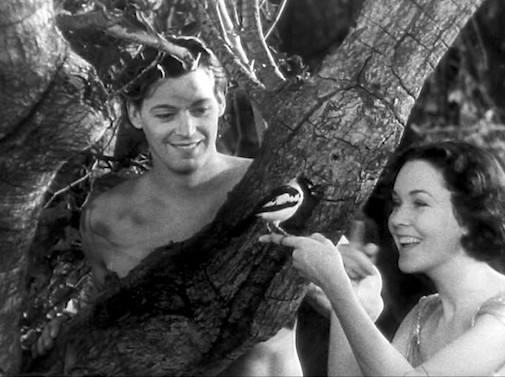 Jane sweet talking a little singing birdie
Jane sweet talking a little singing birdie
Making (implied) love to Tarzan...
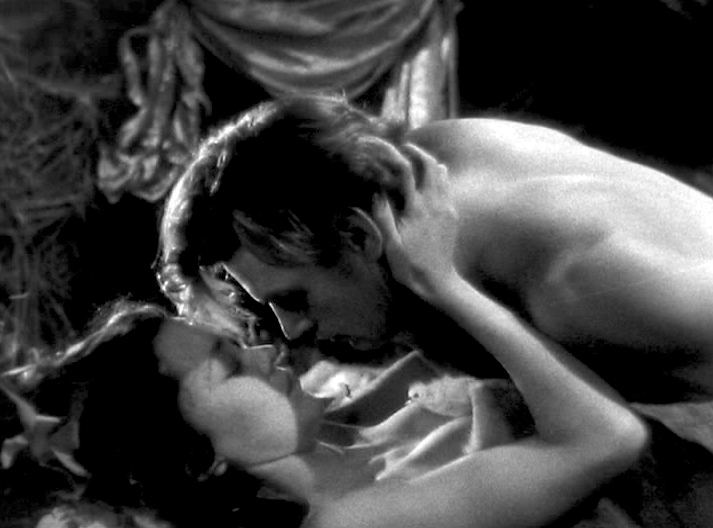 Tarzan and Jane during breakfast (Hint: they're into morning sex)
Tarzan and Jane during breakfast (Hint: they're into morning sex)
Trying on the latest London fashions...
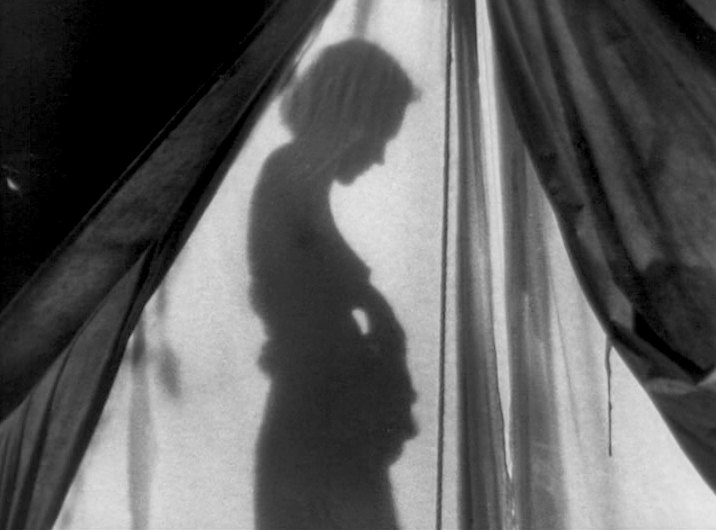
Or taking matters (and weapons) into her own hands.
Tarzan the Ape Man and Tarzan the Fearless both spent significant quality time ogling Weissmuller and Crabbe's Olympian bodies but as implied by this film's shared title, Tarzan and His Mate, the star this time around is actually Maureen O'Sullivan. She's the actress most associated with the franchise since she was a) terrific in the Jane role and b) stuck with it for several films. But at least she wasn't wasting her time, despite a healthy film career outside of the franchise, because she's hardly a wallflower in the pictures; She spends most of the picture bossing Tarzan around (who loves it) and she's given her own agency, her own libido, and her own minor triumphs even within action sequences. The latter is usually not much more than clever survival tactics before Tarzan saves her but it's still something! The best of these is a great bit in the climax when she builds a makeshift fire quicker than any reality contestant on Naked and Afraid to stave off approaching lions. Primitive Survival Rating: 10.0
4 more stray observations from Tarzan and His Mate (1934)
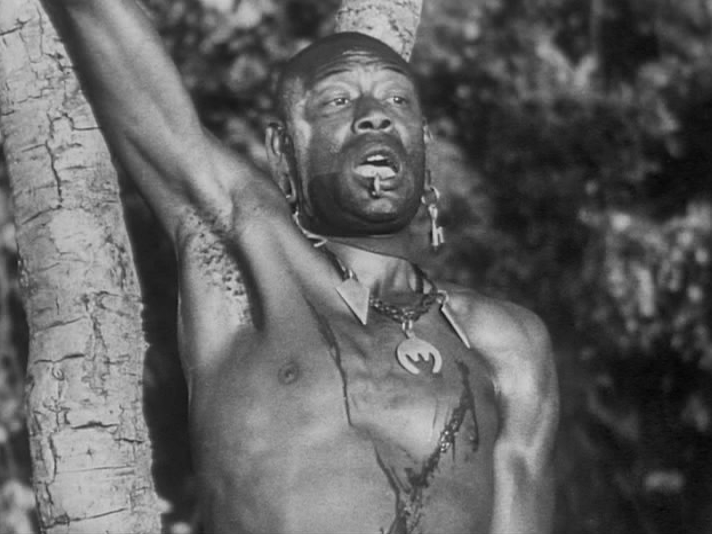 Nathan Curry as Saidi
Nathan Curry as Saidi Extras as native warriors
Extras as native warriors
• I looked up the actor's name above (Texan actor Nathan Curry as "Saidi") because he's the only "native" with significant speaking lines. He's loyal to the bosses and translates for them with the otherwise anonymous natives. The warrior native tribe kills him horrifically in the finale, first by knifing him, then tying him to a tree, and then by sic'ing the lions on him. Harry, a good guy who gradually accepts that Jane loves Tarzan instead of him, tries to save him only to be killed by the lions himself.
Tarzan being a fantasy of imperialism, the race relations in the franchise can be cringeworthy. Take for instance a scene early in the film where Martin shoots one of his black workers at point blank range because he refuses to obey and order. While Martin is the villain of the film, this scene is played so matter of factly that it carries little weight and no repercussions (Surely it was illegal to just kill hired hands when you went to a foreign country?) When his friend Harry suggests he oughtn't to have done that, he only says something callow along the lines of 'you're right. There's one less set of arms to carry the treasure.' but the scene isn't directed to prominently display his villainy, the way shots of him attacking Tarzan or ogling Jane are.
Because these films were shot in Hollywood (on soundstages and in nearby locales) those armies of warrior natives were all basically American groups of extras or bit contract players. I was unable to find any info on Curry but for the fact that his career went largely uncredited in roles like "native," and "guard" in Hollywood. One wonders what these actors did for day jobs or how these jobs paid at the time. Oscar winner Hattie McDaniel (Gone With the Wind) famously quipped that "I'd rather make $700 a week playing a maid than working as one'" but she was an exception. For an African American actor in that day and age she had a robust career appearing frequently in major studio productions right in the frame with the headlining stars.
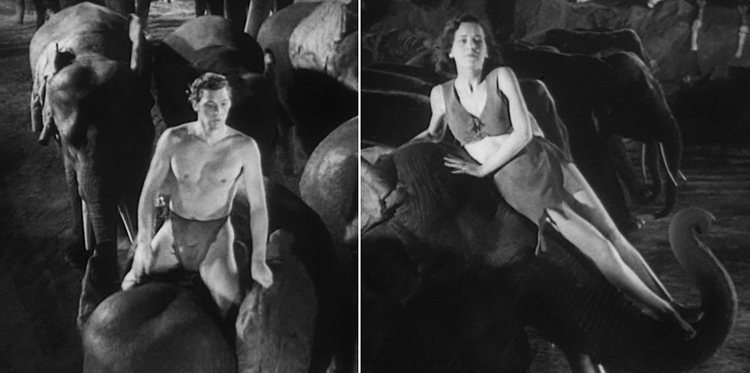
• Tarzan and Jane have very different elephant riding styles... Even in the jungle it's only proper for women to ride side saddle!
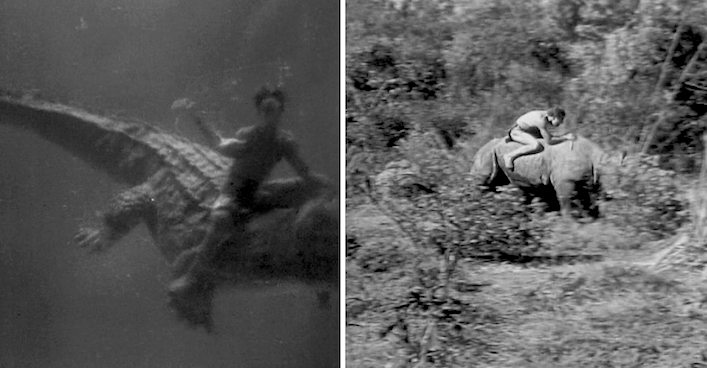
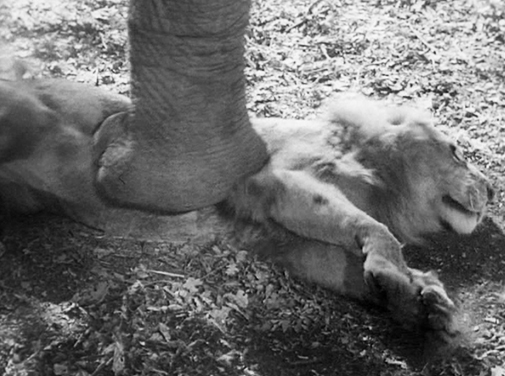
• For all of Tarzan's love of animals, he sure does kill a lot of them. There's a zero tolerance policy on attacking Jane - even growl at her wrong and you're toast. Tarzan only seems to have one attack mode: Leap on top of animal, stab it to death. I wonder how long it will take the movies to vary up his fighting technique or is it just this so they can use stop motion or puppets with more ease? The alligator fight is, let's say, unfortunate in terms of visual fx. Much more exciting is the rhino battle. That's actually Johnny Weissmuller, not even a stunt double, riding a real rhino (some insert shots with the stabbing obviously use a fake rhino, though). FWIW, the elephants are far more creative than their master in terms of their fighting styles. When faced with the herd of lions, they tusk them, throw them with their trunks, and stomp on them with fairly convincing (and for the time complicated) visual fx.
• I'm only going to watch one Tarzan movie per actor for this series (it would take years to watch all the films) but I do wonder if this movie has the most Tarzan yodels in it. He is yelling all. the. time. To these ears, untrained in jungle rhythms, it sounds exactly the same every time but it means a bunch of different things including...
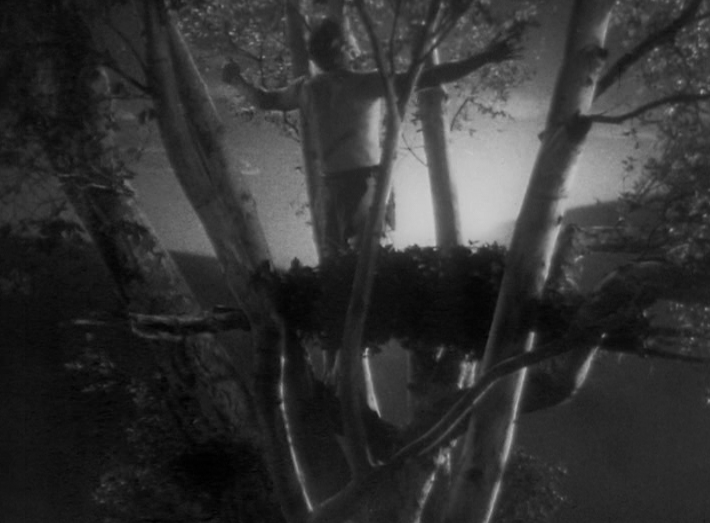 Tarzan mourning dead Cheetah
Tarzan mourning dead Cheetah
- To announce his arrival
- Like mindless humming while performing tasks (the task being swinging on trapeze vines)
- Calling out to Jane
- To gather animals to him (usually elephants but sometimes apes)
- To boss animals around once they're there.
- Announcing his victories
- ...and even to mourn a fallen comrade. SPOILER: Cheetah dies in the picture. But since there's a Cheetah junior in the same film who actually gets more camera time, Cheetah as sidekick endures.
Jane's yodels are far less expressive, meaning mostly one thing...
Tarzan, a wild animal is attacking me again. Come save me!"

All Chapters:
Ch. 1 Buster Crabbe in Tarzan the Fearless (1933)
Ch. 2 Johnny Weissmuller & Maureen O'Sullivan in Tarzan and His Mate (1934)
Archive Extra: Tarzan the Ape Man (1932)
Ch. 3 Lex Barker in Tarzan's Peril (1951)
Ch. 4 Gordon Scott in Tarzan's Great Adventure (1959)
Ch. 5 Mike Henry in Tarzan and The Valley of Gold (1966)
Ch. 6 Bo Derek & Miles O'Keeffe in Tarzan the Ape Man (1980)
Ch. 7 Oscar loves Greystoke, The Legend of Tarzan: Lord of the Apes (1984)



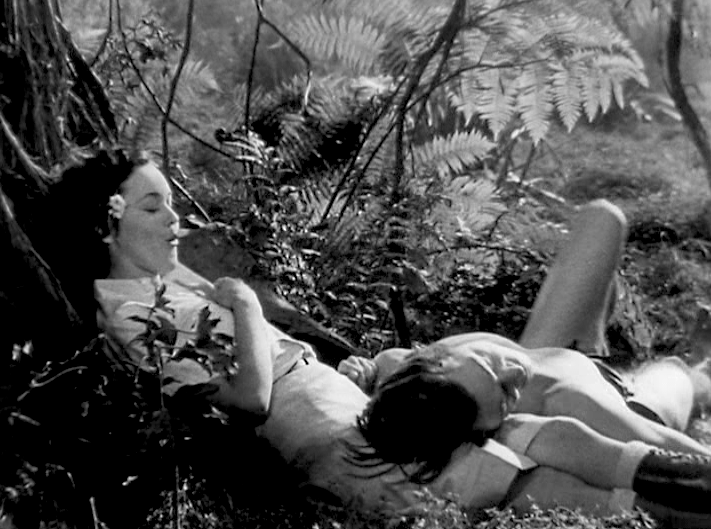
Reader Comments (9)
Nathaniel, like a typical girl of 1930's movie era(Garbo, Lombard, Colbert,
Shearer, Harlow, West, Dietrich, Loy, etc) Maureen O'Sullivan's
Jane is the head of the couple. She's the boss and
chooses to be with him and
certainly teaches Tarzan how to make love/sex
to a female of the human species.
Her occasional naivety is an allowance of the smart screenwriters - deliberately
incoherent. I don't know about the gay men, but Tarzan is part of a female
fantasy - tal, handsome, muscled and can barely speak.
And ready to save you no matter what.
Kimberly -- yeah, she's definitely the boss of him. and i can't speak for collective gay fantasy -- i think Tarzan has fallen out of public fascination mostly so i'm curious how the new film will be received -- but i sure was into him as a child. But then i loved all things wild animals because i also loved Jungle Book (my absolute favorite Disney as a kid... the Sleeping Beauty and Beauty & The Beast / Little Mermaid obsessions came much later.
These are so fun to read! I do appreciate the eager and willing gaze upon men's bodies in this period.
Of course, as you suggest, this serves as an ever potent reminder that (homo)erotic lust for white male bodies in "untamed" lands was central a recurring and central imperial fantasy. The fact that a white woman gets more agency/authority than the often "silent" black male extras also seals it as a particular form of escapism intended for 1930s white audiences.
Jane is no fool
I think part of Jane's power in these films is due to O'Sullivan's screen presence and skill playing the part. She was already an established performer when she was cast in the first film and had a substantial career after exiting, even with quite a break for childbearing. Whereas Weissmuller had Tarzan and then Jungle Jim and that's about it since the athleticism of the role was where he excelled never the nuance of characterization.
Enjoying the series, glad you're going to take a quick look at each Tarzan.
Loved this piece. One of your best. Nicely illustrated too. Especially adored the Jane as Disney Princess shot. I've seen most of the Tarzan films and retain soft spots for many of them (including the wildly exotic ,filmed in Mexico "Tarzan and the Mermaids" , "Tarzan and the Lost City| (with Casper van Dien) and - yes - even the much pilloried John & Bo version from '81) But I'd probably still rank this 1934 one as the best of the bunch. If I had to choose the finest all round big-screen Tarzan, I'd be tempted to go for Gordon Scott. Who wouldn't? But certainly Maureen O'Sullivan is - no contest - the Jane of Janes.
WeiSSmuller.
willy - noted. thanks.
joel -agreed on O'Sullivan. she is really marvelous in these two movies though i'm not as familiar with the later ones before she quit.
kimberly -- i remember when "girl power" was a buzzword in the late 90s and i was always thinking "but watch a 30s movie! they had quite a lot of it."
Nathaniel, I was talking with two female friends about
the today movies and one of them came with:
"when I want to watch a great movie with a great
female role played by a great star
I go to watch a Greta Garbo movie!"
We all laughed and we had to agree.
When I became familiar with the "old movies" and
the great female stars and how they
ruled Hollywood in the great studios era,
I was shocked and happy, and sad now they
don't give the same importance to female stars today.